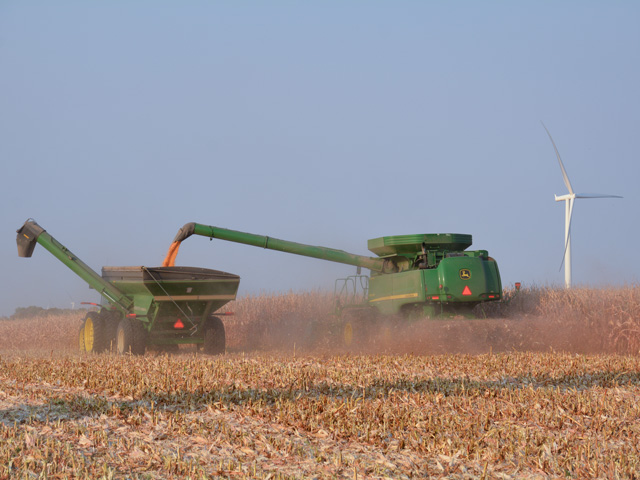Derecho-Damaged Corn Drydown Dilemma
Farmers Face Additional Derecho Challenge: Estimating Corn Drydown
ANKENY, Iowa (DTN) -- Down and tangled corn isn't the only challenge Midwest farmers face as they harvest the crop damaged by the August derecho.
An online corn moisture calculator developed to help farmers determine when a cornfield is dry enough to harvest may give inaccurate estimates in damaged areas. The app also helps mitigate drying expenses and revenue losses from allowing corn to become too dry in the field.
Mark Licht, an Iowa State University (ISU) Extension cropping systems specialist, said a free Corn Drydown Calculator he helped develop with colleagues at ISU and Michigan State University doesn't take into account the change in airflow in fields where corn is flat and/or lodged. The algorithm used to estimate grain moisture drying and content is based on air movement through standing corn.
"The calculator is working well in areas that didn't sustain damage and in areas that were affected by drought," Licht said. "However, (calculator estimates) are not responding as well in damaged areas. The air doesn't move as well through corn, and the moisture on husks and ears from earlier rains is taking longer to dry.
"The calculator will probably underestimate moisture in those areas by a few percentage points," he continued. "For example, if it said 15%, it's probably more like 18%."
The Corn Drydown Calculator, https://crops.extension.iastate.edu/…, was introduced just before the 2019 harvest. It's designed to calculate drydown after corn reaches physical maturity. It may also not be accurate in areas damaged by frost or pests.
Here's how the calculator works:
-- After logging on to the calculator website, an interactive map of much of the Midwest appears. Farmers can zoom in on their location using the satellite or street function.
-- Users enter the date and grain moisture content to calculate probable drydown estimates in the future.
-- The tool uses daily temperature and relative humidity to estimate the atmosphere's drying potential on a given day. This is calculated using an "equilibrium" concept, which is the point where kernels no longer gain or lose moisture to the surrounding air. The calculator also uses historical weather records.
P[L1] D[0x0] M[300x250] OOP[F] ADUNIT[] T[]
-- Drydown projections are calculated using the U.S. National Oceanic and Atmospheric Administration forecast model otherwise known as the Climate Forecast System.
VALUABLE TOOL
Even though farmers should be aware corn moisture forecasts could be skewed in derecho-damaged corn -- USDA's Risk Management Agency estimated 14 million acres of crops were affected by the Aug. 10 storm across the Midwest, and 3.5 million acres of corn in Iowa, which was the worst-hit -- Licht believes the calculator is a valuable tool.
The more opportunity corn has to dry in the field, the less money and time a farmer spends to do it. Corn is typically marketed at 15.5% moisture, weighing 56 pounds per bushel. Corn can be stored at 15.5% moisture for six months or 14% moisture for one year.
"(Moisture content) can be an indicator of when to harvest a field," Licht said. "If a field doesn't have a chance to dry down further and ears are dropping, you don't want to risk that loss. Once moisture falls to 15% and below, a farmer can start losing profits because they are selling the same volume that weighs less."
Nancy Brannaman intends to use the calculator this fall. She lives near Solon, Iowa, but owns a 440-acre farm with two sisters in north-central Illinois. Brannaman manages the farm but hires a local farmer to do the fieldwork.
Brannaman's farm doesn't have enough on-farm storage for all the corn and soybeans in the 50-50 crop rotation, so avoiding or minimizing drying expenses for corn that's sold at harvest is important to the bottom line.
"There are a lot of decisions as far as what (fields) to harvest first," Brannaman said. "I need an idea of what is maturing and drying down faster. This will help me fine-tune where to start and go next. We (myself and custom operator) took a lot of time picking corn varieties for 2020 that have good standability and low ear droppage."
DRYING OPPORTUNITIES
There's still time for corn to dry down in the fields. For example, the latest USDA estimates peg average moisture content of harvested corn in Iowa at 20% and 22% in Minnesota.
In mid-October, Licht said, corn can dry down 0.25 to 0.5 percentage point a day under good conditions, which are warm temperatures and low humidity.
DTN Senior Ag Meteorologist Bryce Anderson expects temperatures to be above normal with very little precipitation over the Corn Belt in mid-October.
"It looks like very good weather for crop drying in the field," Anderson said.
MORE TECHNOLOGY OPTIONS
Drydown models and calculators are becoming more common to help both farmers plan harvests and for grain buyers and related companies to plan for the harvest crunch.
DTN's ClearAg Harvest Advisor estimates grain drydown rates using field-level weather information coupled with user-supplied information of local crop conditions. It also estimates mechanical drydown costs based on real fuel costs and local conditions for corn and other crops such as barley, canola, winter and spring wheat, sorghum and more.
At the moment, Harvest Advisor is primarily aimed at companies to help schedule grain arrival as well as to embed in their digital platforms for farmer customers to use, according to Mike Ostaffe, Harvest Advisor product manager.
The Propane Education & Research Council (PERC) launched Grain Drying Calculator, www.propane.com/propane-products/grain-dryers/, to help producers determine how many gallons of propane is needed to dry corn.
Users of the PERC calculator need to provide corn acres, average yield and targeted percentage of moisture drop.
Matthew Wilde can be reached at matt.wilde@dtn.com
Follow him on Twitter @progressivwilde
(c) Copyright 2020 DTN, LLC. All rights reserved.






